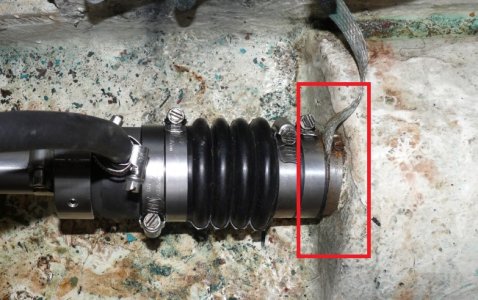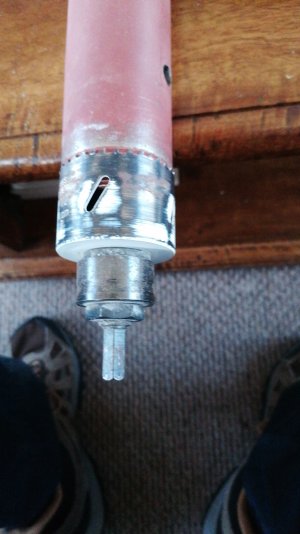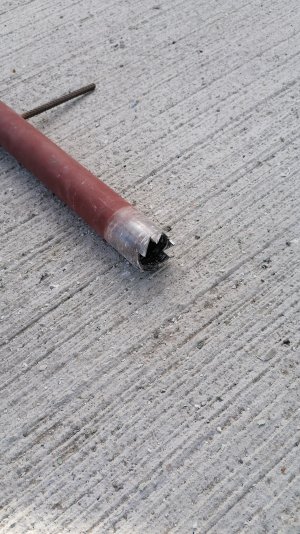Roberto
Well-Known Member
Hello,
my stern tube (see picture with PSS fitted) is made of some unknown copper alloy, came original with the boat which is about 35 year old. It is simply a metal tube glassed through the hull, without any kind of contact with the shaft, it just holds the bellow end of the PSS, the shaft passes through and goes to the separate P-bracket about 70-80cm away.
The copper strap (red box) is tied to the engine, which is not isolated from the shaft so there is continuity up to its underwater anodes (+ propeller and its anodes too). A second copper strap from the engine disappears into the stern, possibly to the P-bracket but I have no idea of its conditions.
This setup has been perfectly satisfactory; about 4-5 years ago I replaced the PSS bellow and the tube was in good conditions, yellow colour, I'd say better than through-hulls of the same age I replaced at the same time.
For some reason the copper strap parted and I did not notice it, the tube has remained isolated during maybe 4 years. A few days ago I checked the now visible area of the tube under the clamp and it was reddish colour, I scratched the surface and was worryingly powdery, the boat being in the water I did not insist, it seems to have dezincified/leached by an unknown extent, I have already used the engine a number of hours with the tube in these conditions but I prepared a sort of emergency kit around it should the tube suddenly break, I'll disassemble everything and check properly at the next lift out.
External conditions fairly constant throughout the years: same marina (or open sea/many very short stays elsewhere), very little use of 230v, normal anode consumption, .
I measured the potentials against an Ag/AgCl electrode and the copper strap was at about -800mV, the shaft was at about -900mV, the now isolated stern tube at -260mV. As the tube decay happened without the strap, I reconnected it again to the tube which is now at same -800mV, hopefully it will revert to the protected stage it seemed to have had for years, waiting for closer inspection.
I'd like to understand what is happening
One can often read that isolated boat underwater fittings made in non-DZR brass alloys will decay with leaching zinc at a rate depending on the initial composition of the alloy, and that no protection can be applied: the bonding through the strap to shaft anodes seems to have provided years of protection from corrosion, if kept isolated my stern tube seems very much bound to destruction. What can explain the case above?
Also, a question for people used to do fiberglass work: how would you proceed to replace the stern tube? Grind away all the fiberglass over it, then place another tube and glass it against the hull? Or try to remove the metal tube by splitting it into several sectors and then insert a new one, adding structural sealant as filler?
It will be done by a boatyard anyway but any ideas welcome.
regards, r.

my stern tube (see picture with PSS fitted) is made of some unknown copper alloy, came original with the boat which is about 35 year old. It is simply a metal tube glassed through the hull, without any kind of contact with the shaft, it just holds the bellow end of the PSS, the shaft passes through and goes to the separate P-bracket about 70-80cm away.
The copper strap (red box) is tied to the engine, which is not isolated from the shaft so there is continuity up to its underwater anodes (+ propeller and its anodes too). A second copper strap from the engine disappears into the stern, possibly to the P-bracket but I have no idea of its conditions.
This setup has been perfectly satisfactory; about 4-5 years ago I replaced the PSS bellow and the tube was in good conditions, yellow colour, I'd say better than through-hulls of the same age I replaced at the same time.
For some reason the copper strap parted and I did not notice it, the tube has remained isolated during maybe 4 years. A few days ago I checked the now visible area of the tube under the clamp and it was reddish colour, I scratched the surface and was worryingly powdery, the boat being in the water I did not insist, it seems to have dezincified/leached by an unknown extent, I have already used the engine a number of hours with the tube in these conditions but I prepared a sort of emergency kit around it should the tube suddenly break, I'll disassemble everything and check properly at the next lift out.
External conditions fairly constant throughout the years: same marina (or open sea/many very short stays elsewhere), very little use of 230v, normal anode consumption, .
I measured the potentials against an Ag/AgCl electrode and the copper strap was at about -800mV, the shaft was at about -900mV, the now isolated stern tube at -260mV. As the tube decay happened without the strap, I reconnected it again to the tube which is now at same -800mV, hopefully it will revert to the protected stage it seemed to have had for years, waiting for closer inspection.
I'd like to understand what is happening
One can often read that isolated boat underwater fittings made in non-DZR brass alloys will decay with leaching zinc at a rate depending on the initial composition of the alloy, and that no protection can be applied: the bonding through the strap to shaft anodes seems to have provided years of protection from corrosion, if kept isolated my stern tube seems very much bound to destruction. What can explain the case above?
Also, a question for people used to do fiberglass work: how would you proceed to replace the stern tube? Grind away all the fiberglass over it, then place another tube and glass it against the hull? Or try to remove the metal tube by splitting it into several sectors and then insert a new one, adding structural sealant as filler?
It will be done by a boatyard anyway but any ideas welcome.
regards, r.



